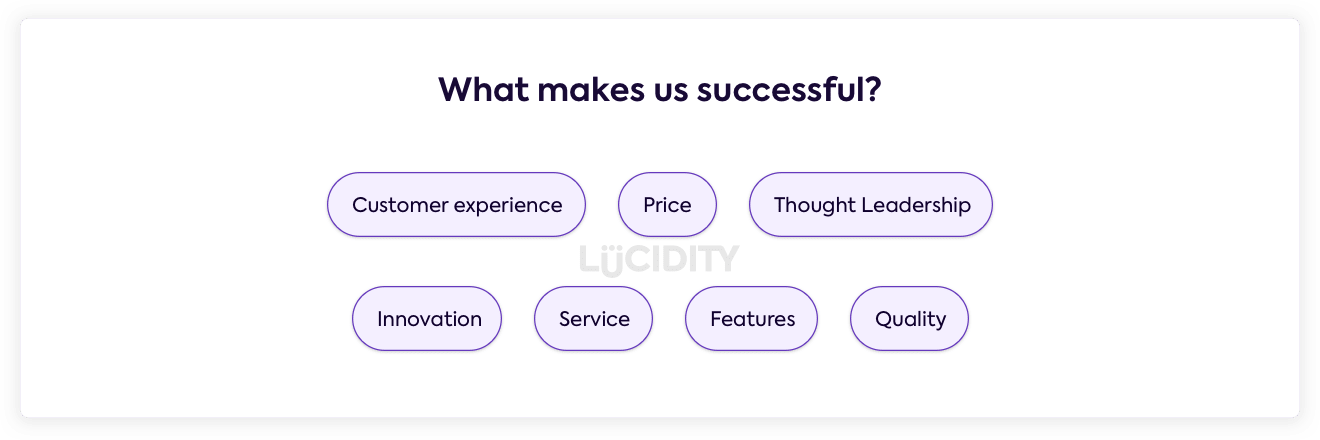A vision statement is the guiding star of your strategy.
Getting the right company vision statement can be an enjoyable process and it’s worth spending some time on it because a good vision statement underpins everything about your strategic direction. When done well it will be memorable, engaging, informative and inspiring.
If you’re new to Vision statements it’s worth checking out our Introduction To Vision Statements article. You can also develop your Business Vision statement inside the Lucidity strategy software as part of your strategy formulation.
Your vision statement is the foundation of your business values and it’s often the first impression investors and potential employees get about you and your company, so it needs to be the best it can be.
The business vision statement is often confused with the mission statement. The mission statement answers the question "What do we do?" The business vision statement answers the question "What will we become?"
Before we get into the detail of how to write a Vision statement, let’s establish some key guidelines:
- No more than two sentences and keep it under 30 words
- Keep it simple and digestible
- Avoid metrics – these don’t belong in your Vision
- Be specific in your wording and your make it relevant to your market
- Make it inspiring and ambitious
- Align it to your culture and company’s core values
Be ready to make some edits. It’s going to take a few attempts to get a Vision statement that works well and you want to make sure you get it right.
Step 1: Associated Word Generation
When you think of your company a number of associated words will come to mind. Write them all down, they can be values, market, industry, aspirations. Put them all down in a word cloud and you’ll end up with something like this:
“People working together as a lean, global enterprise to make people’s lives better through automotive and mobility leadership.” – Ford
Step 2: Success Word Generation
We’re going to write another word cloud now, this time containing words that make you successful. Why is it your business succeeds or will succeed when others fail? What do you compete on? Again jot down as many words as come to mind and you’ll end up with a another cloud:
"Dedication to creating the most epic entertainment experiences…ever" – Blizzard
Step 3: The Obvious Sentence
Now you’ve got your key words and inspiration it’s time to begin forming your Vision. This is an external statement, so begin by writing down what it is you do and why your business exists to the outside world. Remember to look at some examples to get a good idea of existing Vision statements.
Don’t worry about the flow or how it reads, just write down a starting sentence and stay focused on the why and external nature of the statement.
Once done, do another three or four as standalone alternatives, referring back to your word cloud.
“To accelerate the world’s transition to sustainable energy.” – Tesla
Step 4: The First Draft
You’re going to write another sentence now that becomes the first attempt at your real Vision. Compare your sentences and the words, what do you like about each? Highlight the parts that feel inspiring and accurate.
Now write a new Vision statement incorporating elements from the original sentence and some of the words from your clouds. Try to develop a Vision statement that produces a mental image when read and uses positive, emotive language.
"A just world without poverty" -Oxfam
Step 5: Refinement
There’s a balance with a Vision statement to not make it too generic but not be too specific. If you go too generic it becomes meaningless, go too specific and it opens itself up for negativity if people do not believe in it.
Review the vision with the team and ask the following questions:
- Does it resonate?
- Is it memorable?
- Is it easy to understand?
- Does it factor geography and customer demographics?
- Is it meaningful both internally and externally?
Vision Creation Summary:
We hope you enjoyed going through this process. Your excellent Vision statement has now been created – congratulations!
Place it on the wall, include it in company meetings, get the business behind it, and be proud of your inspiring and strong Vision statement. 💪
















